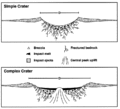William Kenneth Hartmann
| William K. Hartmann | |
|---|---|
| Born | June 6, 1939 New Kensington, Pennsylvania, U.S. |
| Fields | planetary science |
| Institutions | Planetary Science Institute |
| Alma mater | Pennsylvania State University University of Arizona |
| Notable awards | G.K. Gilbert Award, Carl Sagan Medal for Excellence in Public Communication in Planetary Science |
William Kenneth Hartmann (born June 6, 1939) is a noted planetary scientist, artist, author, and writer. He was the first to convince the scientific mainstream that the Earth had once been hit by a planet sized body (Theia), creating both the moon and the Earth's 23.5° tilt.[1]
Born in Pennsylvania in 1939,[2] he received his B.S. in physics from Pennsylvania State University, and an M.S. in geology and PhD in astronomy from the University of Arizona. His career spans over 40 years, from work in the early 1960s with Gerard Kuiper on Mare Orientale, and work on the Mariner 9 Mars mapping project, to current work on the Mars Global Surveyor imaging team. He is currently a senior scientist at the Planetary Science Institute.
Strongly influenced by Chesley Bonestell, he has long been one of America's leading space artists, and has written and illustrated, often collaboratively with artist Ron Miller, numerous books on the history of Earth and the Solar System.
Hartmann is a Fellow of the International Association of Astronomical Artists. His written work also includes textbooks, short fiction, and novels, the most recent being published in 2002. In 1997 he was the first recipient of the Carl Sagan Medal for Excellence in Public Communication in Planetary Science from the American Astronomical Society, Division for Planetary Sciences.
Hartmann was a member of the 1966–1968 University of Colorado UFO Project, informally known as the Condon Committee, a controversial public study of UFOs sponsored by the U.S. Air Force. He primarily investigated photographic evidence, rejecting most as unreliable or inconclusive, but in his studies published in the Committee's final report, Hartmann concluded two cases were unexplained and particularly noteworthy as probative evidence of the reality of UFOs.
Asteroid 3341 Hartmann is named after him.
Bibliography
- Out of the Cradle: Exploring the Frontiers beyond Earth, with Ron Miller and Pamela Lee (1984)
- The History of Earth: An illustrated chronicle of an evolving planet, with Ron Miller (1991)
- Mars Underground, (1997)
See also
References
- ↑ Birth of the Planet, November 24, 2008, Channel 4
- ↑ Lua error in package.lua at line 80: module 'strict' not found.
External links
- William K. Hartmann at the Internet Speculative Fiction Database
- William Hartmann at the Internet Movie Database
- William K. Hartmann on Novaspace
- William Hartmann's Home Page
Lua error in package.lua at line 80: module 'strict' not found.
- Use mdy dates from October 2015
- Living people
- 20th-century American novelists
- 20th-century astronomers
- 21st-century astronomers
- American astronomers
- American science writers
- American science fiction writers
- American male novelists
- American short story writers
- American UFO writers
- American artists
- Space artists
- Pennsylvania State University alumni
- Planetary scientists
- Ufologists
- University of Arizona alumni
- 1939 births
- American male short story writers

